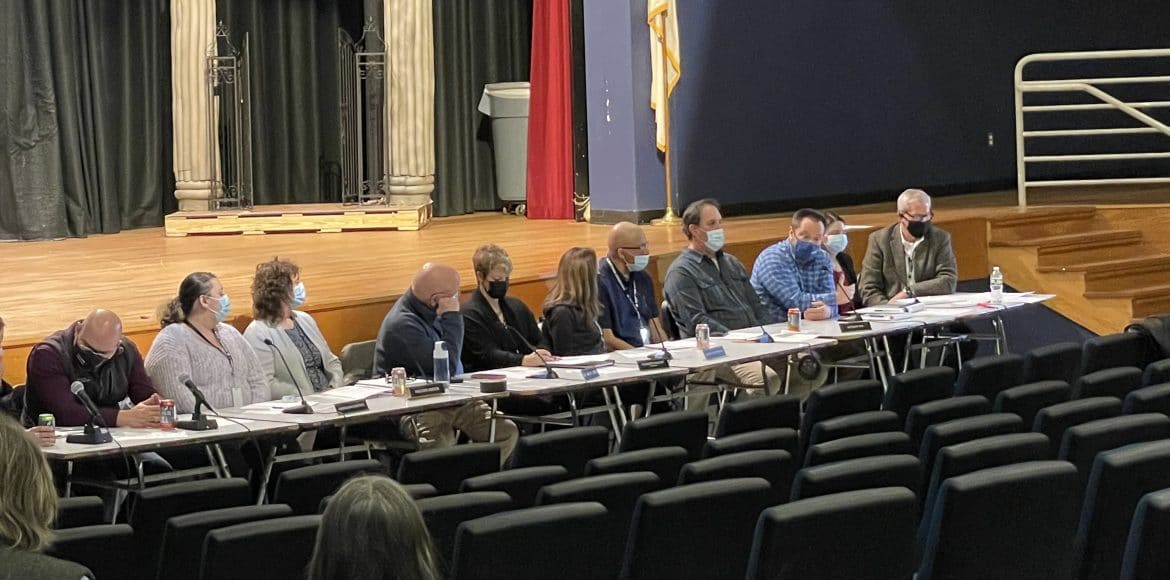“You don’t have a plan B,” Kristen Mello told the Nantucket School Committee and a panel of island officials Tuesday evening during a workshop session to discuss the controversial turf fields proposed for the public school campus and the potential risks of the so-called “forever chemicals” PFAS used to manufacture them.
Mello was among the group of PFAS experts assembled by the Nantucket PFAS Action Group to speak last night, and was referring to the potential for PFAS to leach from the turf fields and contaminate the island’s sole source aquifer. That was among the hottest topics during the workshop session that provided the School Committee the chance to ask questions of the experts and panelists, while affording attendees the opportunity to submit written questions.
Approximately 60 people attended the meeting, including members of the Nantucket Fire Department, some of whom have been highly critical of the school’s decision to include the two turf fields in the plans for the proposed $17.5 million campus-wide athletic facilities project.
Representing the school’s project team were toxicologist Marie Rudiman and hydrogeologist Steve Larosa, of Weston & Sampson, the firm that was hired by the school to evaluate the risks of PFAS in turf fields and answer questions from the public. Rudiman and Larosa emphasized that testing showed the existing soil on the current athletic fields already have “background concentrations” of PFAS due to ubiquitous nature of the chemicals in the environment. The proposed turf fields, they said, would have similar or lesser concentrations of the chemicals.
Asked by School Committee member Esmeralda Martinez if they would impact the island’s aquifer, Larosa said “That’s a loaded question. From what we have seen in the laboratory analysis done on these materials proposed for the turf fields, there are low, estimated concentrations of PFAS that appear to be present in some of these materials and in a leaching test, where they put what is supposed to be, chemically, rainwater on these materials to see what leaches, low levels of PFAS are released by some of these materials. The concentrations they’re observing are comparable to or less than what has been observed in rainwater and what we have in our bodies and excrete every day.”
The PFAS experts who were participating in the workshop remotely repeatedly took exception to the comments made by Larosa and Rudiman, and emphasized the lack of long-term studies on the impacts of PFAS, as well as the changing regulatory environment that could soon become far more strict on what is considered a “safe” level of PFAS in drinking water.
Currently, the federal standard for drinking water is 70 parts per trillion (PPT), while Massachusetts has set its standard at 20 ppt, one of the most conservative in the country.
“We have seen some data that shows when artificial turf fields are put in, the surrounding wetlands and groundwater does increase in PFAS levels,” said Dr. Kyla Bennett, the director of science policy at New England Public Employees for Environmental Responsibility (PEER) and a former EPA employee. “My town didn’t have a PFAS problem until we put in turf fields. To say it’s not going to contaminate the groundwater or aquifer is not true.”
Another notable development during last night’s meeting was Nantucket Land Council executive director Emily Molden indicating her organization was weighing in against the proposed installation of turf fields over the potential for water contamination.
“The science is too young for a full assessment of PFAS risk,” Molden said. “Overall, these results represent a risk that at this time is unquantifiable. The Land Council, based on what we know, feels it’s not an appropriate risk to be taking in our wellhead contribution zone.”
Dr. Tim Lepore, the chair of the School Committee, had advocated in favor of having the outside experts suggested by the Nantucket PFAS Action Group participate in the meeting. He had some colorful exchanges with the Weston & Sampson consultants.
“Do we need more PFAS?” he asked. “It seems we have a background level and we’re going to add to it?
“There isn’t a soil that we can bring in that will be cleaner than what you have now as natural material,” Larosa countered. “The turf and the pad is testing at a lower concentraiotn than what you have now.”
Lepore responded: “It seems to me if you add one and one you get two. Everyone thought the Challenger was fine and ready to go, and then there was a whoopsie. If we have a whoopsie here, we’ve contaminated our water.”
The next stop for the school’s campus-wide athletic fields project is today at the Nantucket Select Board meeting. Town Meeting voters will have the opportunity to vote on spending for the project in May.






